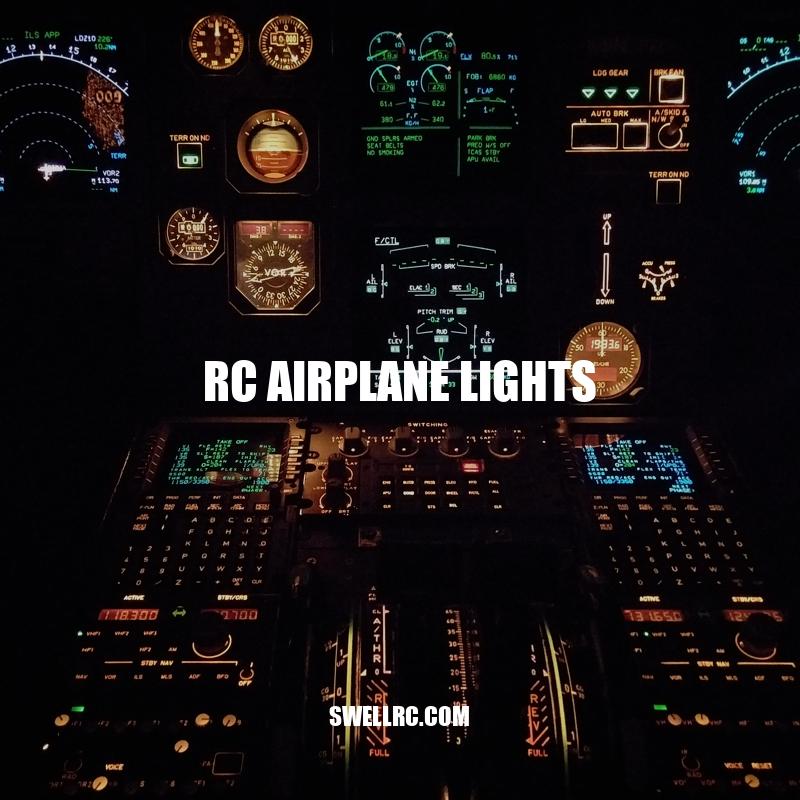Ultimate Guide to RC Airplane Lights: Installation, Benefits, and Choosing the Right Lights
RC Airplane Lights – The Basics
As the popularity of radio-controlled model airplanes grows, so does the demand for accessories that make these hobby crafts look and function like real airplanes. RC airplane lights are one such accessory that can transform a simple model airplane into a stunning-looking flying machine with realistic features. These lights replicate the actual lights on airplanes and provide adequate illumination to help track the plane during flight. Additionally, they enhance the plane’s aesthetic value, especially when flying at night. RC airplane lights come in various styles, sizes, and colors. Hobbyists can choose from simple LED lights to more complex lighting systems that can produce multiple flashing patterns and sound effects.
For the enthusiast who has already invested in other accessories such as upgraded engines, larger propellers, and sophisticated control systems, RC airplane lights are a welcome addition that continues to improve the flying experience. Depending on your personal preferences, it is possible to customize the lighting systems to suit your style and aircraft design. With the right RC airplane lights installed, your aircraft will stand out from the rest at the airfield. In this article, we take a closer look at RC airplane lights – their uses, types, installation process, and important factors to consider when choosing them.
RC airplane lights are not only aesthetically pleasing, but they can also improve your flying experience in several ways. Here are some reasons why you should consider investing in RC airplane lights:
- Enhanced visibility: RC airplane lights provide better visibility during low-light conditions. This feature is particularly useful when you’re flying your model aircraft in the evening or at night.
- Safety: The lights also make your aircraft more visible to other pilots and observers. This aspect makes it easier to avoid collisions, thereby promoting safety during group flights.
- Realism: The lights give your model aircraft a realistic look and feel, bringing it a step closer to resembling a real-life aircraft.
- Customization: With RC airplane lights, you can customize your lighting system to suit your personal preferences. You can choose the type of lights you want, their placement on the aircraft, and the colors you prefer.
In addition to these benefits, RC airplane lights also add flair to your flying performance, making it a spectator sport that many people would enjoy watching. There are many websites that sell RC airplane lights, and you can find them in different shapes, designs, and colors. Some products come with installation instructions, while others require you to improvise using your experience and common sense. Choosing the right RC airplane lights for your model aircraft need not be a daunting task. In the following sections, we’ll explore the various types of RC airplane lights, how to install them, and what you need to consider when choosing them.
What is the advantage of RC plane?
RC planes have a few advantages over other types of aircraft such as being cheaper than drones and suitable for beginners in aero flying. They are used mainly for recreational purposes and can foster creativity and practical skills when constructed at home. No specific websites or products were mentioned.
RC airplane lights are a simple and easy way to add a new level of excitement and realism to your model aircraft. Whether you fly at night or during the day, installing lights on your RC airplane can help you keep track of your airplane’s orientation and create a visually stunning flying experience.
Installing RC airplane lights is a simple process that you can do on your own. The first step is to identify the areas on your model aircraft where you want to install the lights. These areas could be the wingtips, fuselage, or tail section, depending on the type of lights you have.
Once you have identified the installation areas, you need to drill small holes in the areas to create an opening for the lights. Ensure that the holes you drill are the correct size and shape for the lights you’re using.
The next step is to insert the lights into the holes you drilled. Ensure that they are secure and stable. You can power the lights using a separate battery pack or by connecting them to the receiver battery. If you’re using LED lights, you may need to connect a resistor to protect the lights from burning out.
After you have installed the lights, it’s essential to test them to ensure that they’re working correctly. If you’re using an advanced lighting system with multiple patterns and sound effects, you may need to program it before testing it out.
Different types of RC airplane lights require different installation techniques. For example, if you’re using wingtip lights, you’ll need to install them using adhesive tapes, while fuselage lights require drilling and mounting brackets. Improper installation can damage your model aircraft or reduce the effectiveness of the lights.
If you’re unsure about how to install your RC airplane lights, many websites offer installation guides and tutorials that can help. Additionally, you can seek advice from other model aircraft enthusiasts who have experience installing lights on their planes. Remember, the goal is to install them correctly and safely to reap the benefits that come with using RC airplane lights.
Is it hard to build an RC plane?
Building an RC plane is not too difficult as it requires a little planning and a few materials. With the main components such as the body, wings, rudder, wheels, motor and radio transmitter, anyone can become an expert at building RC airplanes within a few hours. For more information and tips, there are websites such as RC Groups and Flite Test that provide helpful resources for RC plane enthusiasts.
Choosing the Right RC Airplane Lights
Choosing the right RC airplane lights can be quite challenging, especially if you’re new to this hobby. Here are some factors to consider when choosing the right RC airplane lights for your model aircraft.
- Type of Lights: RC airplane lights come in various types, including single LED lights, multi-colored lights, and advanced lighting systems. Choose the type that best suits your needs.
- Color Selection: Some of the most common colors for RC airplane lights are blue, green, red, and white. You can choose a single color or combine multiple colors for a more dynamic effect.
- Brightness: Ensure that the lights are bright enough to be visible, even in low-light conditions.
- Power Source: RC airplane lights can be powered using a separate battery pack or connected to the receiver battery. Consider which option is more convenient for you.
- Price: The cost of RC airplane lights varies depending on the type and brand. Single LED lights are generally more affordable, while advanced lighting systems are more expensive.
It’s worth noting that not all RC airplane lights are compatible with every type of model aircraft. Ensure that the lights you choose are suitable for your aircraft type to avoid compatibility issues.
If you’re unsure about which RC airplane lights to choose, check out some of the reputable RC airplane websites that offer a range of lighting options. Additionally, you can consult with experienced model aircraft enthusiasts on online forums or social media groups to get advice on which lights work well with your aircraft.
Finally, once you’ve chosen your RC airplane lights, ensure that you follow the installation instructions carefully to achieve an optimal flying experience.
What are the different types of aircraft lights?
There are several types of aircraft lights, including navigation lights, anti-collision beacon lights, strobe lights, logo lights, wing lights, taxi lights, and landing lights. Navigation lights are found near the leading edge of each wingtip, while anti-collision beacon lights flash to draw attention to the aircraft. Strobe lights are used to make the aircraft more visible, and logo lights illuminate the airline’s logo on the tail of the aircraft. Wing lights help with visibility during taxiing, while taxi lights illuminate the taxiway ahead of the aircraft. Finally, landing lights help the pilot see the runway during takeoff and landing. For more detailed information about aircraft lights, you can visit aviation websites or browse aviation products on online stores.
Conclusion
In conclusion, RC airplane lights are an exciting addition to any model aircraft enthusiast’s collection. They provide a more realistic touch to model aircraft, making them look more like real-life planes in the sky. Additionally, RC airplane lights offer greater visibility, safety, and a more immersive flying experience, especially at night or low-light conditions.
When choosing the right RC airplane lights for your model aircraft, consider the type of lights, color selection, brightness, power source, and price. Ensure that the lights you choose are compatible with your aircraft type to avoid any compatibility issues.
With the availability of reputable RC airplane websites, online forums, and social media groups, it’s easier than ever to learn about RC airplane lights and get advice on which lights to choose for your model aircraft.
RC airplane lights are indeed an exciting accessory to add to your collection. They offer a new level of realism, immersion, and safety to your flying experience. So why not give them a try and take your model aircraft flying to the next level?



